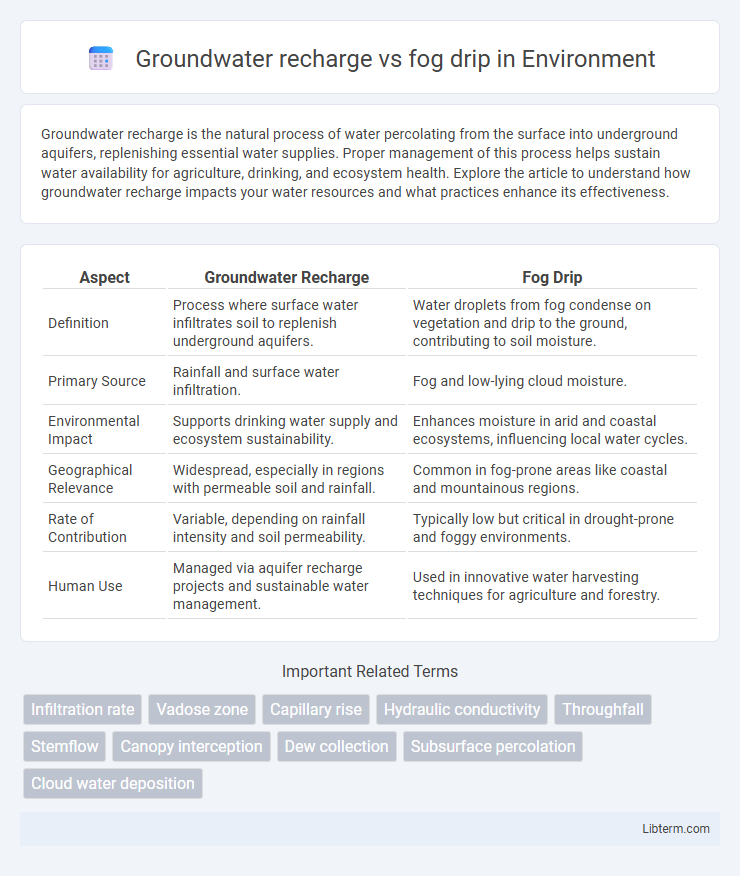Groundwater recharge is the natural process of water percolating from the surface into underground aquifers, replenishing essential water supplies. Proper management of this process helps sustain water availability for agriculture, drinking, and ecosystem health. Explore the article to understand how groundwater recharge impacts your water resources and what practices enhance its effectiveness.
Table of Comparison
| Aspect | Groundwater Recharge | Fog Drip |
|---|---|---|
| Definition | Process where surface water infiltrates soil to replenish underground aquifers. | Water droplets from fog condense on vegetation and drip to the ground, contributing to soil moisture. |
| Primary Source | Rainfall and surface water infiltration. | Fog and low-lying cloud moisture. |
| Environmental Impact | Supports drinking water supply and ecosystem sustainability. | Enhances moisture in arid and coastal ecosystems, influencing local water cycles. |
| Geographical Relevance | Widespread, especially in regions with permeable soil and rainfall. | Common in fog-prone areas like coastal and mountainous regions. |
| Rate of Contribution | Variable, depending on rainfall intensity and soil permeability. | Typically low but critical in drought-prone and foggy environments. |
| Human Use | Managed via aquifer recharge projects and sustainable water management. | Used in innovative water harvesting techniques for agriculture and forestry. |
Introduction to Groundwater Recharge and Fog Drip
Groundwater recharge involves the process where water from precipitation or surface water infiltrates the soil, replenishing aquifers and maintaining subsurface water levels essential for ecosystems and human consumption. Fog drip occurs when water droplets from fog condense on vegetation, contributing to localized moisture input, particularly in arid and coastal regions where traditional rainfall is limited. Understanding the dynamics of groundwater recharge and fog drip is crucial for water resource management, especially in drought-prone or foggy environments.
Defining Groundwater Recharge
Groundwater recharge is the process by which water from precipitation and surface sources percolates through soil and rock layers, replenishing underground aquifers. Unlike fog drip, where moisture condenses on vegetation and drips to the ground, groundwater recharge involves the slow infiltration of water that sustains groundwater supplies essential for ecosystems and human consumption. Effective groundwater recharge depends on soil permeability, rainfall intensity, and vegetation cover, making it a critical component of the hydrological cycle.
Understanding Fog Drip Processes
Fog drip significantly contributes to groundwater recharge in arid and semi-arid regions by capturing moisture from fog-laden air and depositing it onto vegetation and soil surfaces. This process enhances soil moisture levels, which percolate downward to replenish aquifers, often complementing traditional rainfall-based recharge mechanisms. Understanding fog drip processes involves analyzing factors such as fog density, vegetation type, surface roughness, and microclimate conditions that influence the interception and subsequent infiltration rates.
Key Differences Between Groundwater Recharge and Fog Drip
Groundwater recharge is the process where water from precipitation or surface sources infiltrates the soil and replenishes underground aquifers, essential for sustainable water supply. Fog drip refers to the condensation of fog on vegetation, which then drips to the ground, contributing to localized soil moisture but typically not significantly recharging deep groundwater reserves. The key difference lies in groundwater recharge being a broad hydrological process affecting aquifer levels, while fog drip primarily influences surface soil moisture and microclimates in fog-prone ecosystems.
Climatic Conditions Favoring Groundwater Recharge
Climatic conditions favoring groundwater recharge typically include regions with moderate to high precipitation, permeable soils, and seasonal rainfall patterns that allow water to infiltrate the soil and reach aquifers. Fog drip, often found in coastal or mountainous environments with frequent fog and high humidity, contributes to groundwater recharge by depositing moisture directly onto vegetation and soil, supplementing precipitation in otherwise dry climates. Areas with consistent fog events combined with porous substrates exhibit enhanced groundwater recharge rates through this unique natural process.
Geographic Areas Where Fog Drip Occurs
Fog drip significantly contributes to groundwater recharge in coastal and mountainous regions, especially along the Pacific Coast of North America, the Canary Islands, and parts of Chile. These geographic areas experience frequent fog events that enable moisture to condense on vegetation, dripping into the soil and augmenting natural aquifer replenishment. In comparison, traditional groundwater recharge primarily relies on direct rainfall infiltration, making fog drip a critical water source in arid and semi-arid climates where precipitation is limited.
Hydrological Significance of Each Process
Groundwater recharge replenishes aquifers by percolating rainfall and surface water through soil, ensuring sustainable water supply and maintaining baseflow in rivers. Fog drip contributes moisture in fog-prone ecosystems by intercepting cloud moisture on vegetation, enhancing local water input where rainfall is limited. Both processes play crucial roles in hydrological balance, with groundwater recharge supporting large-scale aquifer systems and fog drip sustaining microclimates and biodiversity in arid and coastal regions.
Ecological Impacts of Groundwater Recharge vs Fog Drip
Groundwater recharge replenishes aquifers, supporting plant growth and maintaining stream flows, crucial for sustaining ecosystems during dry periods. Fog drip contributes moisture directly to vegetation and soil surfaces, enhancing local biodiversity and providing critical water in arid environments. Both processes play vital roles in maintaining ecological balance, yet groundwater recharge influences broader hydrological cycles while fog drip primarily supports microhabitats.
Human Interventions and Management Strategies
Human interventions in groundwater recharge often involve artificial recharge techniques such as constructing recharge wells, infiltration basins, and managed aquifer recharge systems to enhance subsurface water storage. Fog drip management strategies focus on preserving and restoring vegetation that maximizes fog capture, thereby sustaining natural water inputs to ecosystems. Effective management integrates monitoring technologies and policy frameworks to balance water resource use while mitigating impacts from urbanization and climate change.
Future Prospects Amidst Climate Change
Groundwater recharge and fog drip are vital water sources sustaining ecosystems and mitigating drought impacts amid climate change. Enhanced fog drip capture technologies and restoration of natural vegetation can significantly increase local water availability, addressing reduced precipitation and groundwater depletion. Future prospects emphasize integrating these methods into adaptive water management strategies to bolster resilience against shifting climate patterns and prolonged dry periods.
Groundwater recharge Infographic

 libterm.com
libterm.com